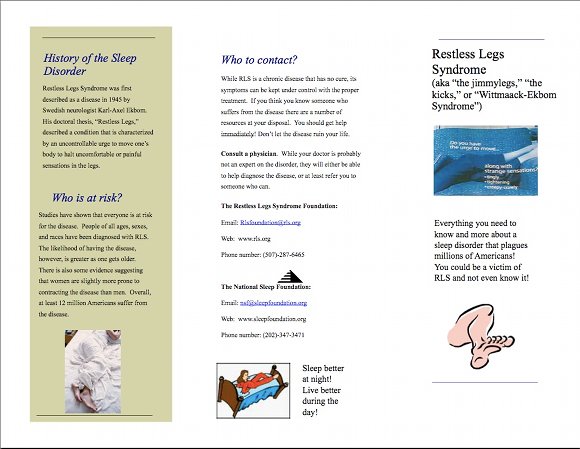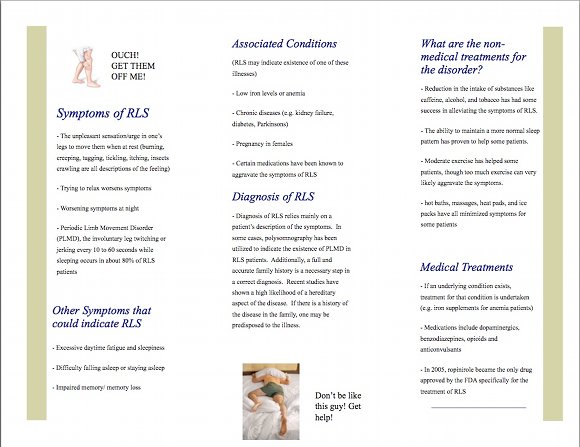
| Connect & Subscribe |
Restless Leg Syndrome
(aka "the jimmylegs," "the kicks," or "Wittmaack-Ekbom Syndrome")
An Outreach Project by Ryan Thatcher | Return To Outreach Projects 2010
The following is a brochure created for Stanford Sleep and Dreams. If it is difficult to read using the images, you may view the text here.
Also feel free to download this brochure for distributional or general information purposes. Please refer to our privacy policy for our relevant disclaimers.


Everything you need to know and more about a sleep disorder that plagues millions of Americans! You could be a victim of RLS and not even know it!
History of the Sleep Disorder
Restless Leg Syndrome was first described as a disease in 1945 by Swedish neurologist Karl-Axel Ekbom. His doctoral thesis, "Restless Legs," described a condition that is characterized by an uncontrollable urge to move one's body to halt uncomfortable or painful sensations in the legs.
Who is at risk?
Studies have shown that everyone is at risk for the disease. People of all ages, sexes, and races have been diagnosed with RLS. The likelihood of having the disease, however, is greater as one gets older. There is also some evidence suggesting that women are slightly more prone to contracting the disease than men. Overall, at least 12 million Americans suffer from the disease.
Symptoms of RLS
- The unpleasant sensation/urge in one's legs to move them when at rest (burning, creeping, tugging, tickling, itching, insects crawling are all descriptions of the feeling)
- Trying to relax worsens symptoms
- Worsening symptoms at night
- Periodic Limb Movement Disorder (PLMD), the involuntary leg twitching or jerking every 10 to 60 seconds while sleeping occurs in about 80% of RLS patients
Other Symptoms that could indicate RLS
- Excessive daytime fatigue and sleepiness
- Difficulty falling asleep or staying asleep
- Impaired memory/ memory loss
Associated Conditions
(RLS may indicate existence of one of these illnesses)
- Low iron levels or anemia
- Chronic diseases (e.g. kidney failure, diabetes, Parkinsons)
- Pregnancy in females
- Certain medications have been known to aggravate the symptoms of RLS
Diagnosis of RLS
- Diagnosis of RLS relies mainly on a patient's description of the symptoms. In some cases, polysomnography has been utilized to indicate the existence of PLMD in RLS patients. Additionally, a full and accurate family history is a necessary step in a correct diagnosis. Recent studies have shown a high likelihood of a hereditary aspect of the disease. If there is a history of the disease in the family, one may be predisposed to the illness.
What are the non-medical treatments for the disorder?
- Reduction in the intake of substances like caffeine, alcohol, and tobacco has had some success in alleviating the symptoms of RLS.
- The ability to maintain a more normal sleep pattern has proven to help some patients.
- Moderate exercise has helped some patients, though too much exercise can very likely aggravate the symptoms.
- hot baths, massages, heat pads, and ice packs have all minimized symptoms for some patients
Medical Treatments
- If an underlying condition exists, treatment for that condition is undertaken (e.g. iron supplements for anemia patients)
- Medications include dopaminergics, benzodiazepines, opioids and anticonvulsants
- In 2005, ropinirole became the only drug approved by the FDA specifically for the treatment of RLS
Who to contact?
While RLS is a chronic disease that has no cure, its symptoms can be kept under control with the proper treatment. If you think you know someone who suffers from the disease there are a number of resources at your disposal. You should get help immediately! Don't let the disease ruin your life.
Consult a physician. While your doctor is probably not an expert on the disorder, they will either be able to help diagnose the disease, or at least refer you to someone who can.
The Restless Legs Syndrome Foundation:
Email: Rlsfoundation@rls.org
Web: www.rls.org
Phone number: (507)-287-6465
The National Sleep Foundation:
Email: nsf@sleepfoundation.org
Web: www.sleepfoundation.org
Phone number: (202)-347-3471
About This Site
Welcome! This site is continuously being created by students of Dr. William C. Dement's Sleep And Dreams course at Stanford University.
We made this site as a call to action for people all over the world to live healthier, happier, safer, and more productive lives by learning about their own sleep. We have faith that reading the information provided on this site will motivate you to be smart about your sleep deprivation and strategic about your alertness in order to live life to your fullest, most energetic potential.
In fact, we challenge you to do so! What do you say, are you up for the challenge?
Interviews With Sleep Specialists: Insights Into the Worlds of Sleep Medicine & Sleep Business
America's Most Dangerous Disorder: What Is Sleep Apnea Doing To Your Sleep?
Sleep Debt: How Much More Will You Achieve When You Reduce Yours?
The Stages Of Sleep: The Journey Through The Night
Delayed Sleep Phase: You Want To Sleep But You're Not Tired Yet
Paralyzed at Night: Is Sleep Paralysis Normal?
Sleep In Words: Smart, Strange, and Funny Quotes About Sleep
Sleep Disorders In Children: What's Keeping Your Child From A Full Night's Rest?
Attacks of Pavor Nocturnus (a.k.a. Sleep Terrors, Night Terrors, or Incubus Attacks)
The Stanford Sleep Book
Dr. Dement's pioneering textbook has been the core text for Sleep and Dreams since 1980, but it has just recently been made available to the wider public for the first time.
In it you'll find a more detailed account of the most important things you need to know about sleep, alertness, dreams, and sleep disorders. Studies, statistics, plus plenty of Dr. Dement's classic anecdotes painting the history of sleep medicine.
Preface | Intro | Contents | Get A Copy
More Sleep Resources
The Zeo
A revolution in personal sleep tracking, the Zeo is a wireless headband that transmits your brainwaves in realtime to a dock (pictured here) or your smartphone. The result? You can wake up and see exactly what stages of sleep you were in during the night! Unprecedented personalized sleep knowledge.
Sleep Paralysis: A Dreamer's Guide
Ever woken up paralyzed? A surprising number of us have, believe it or not. But few know the actual causes of this phenomenon, and fewer still how to exert control over it. Dream researcher and sleep paralysis expert Ryan Hurd shares breakthrough insights into how to do just that.
Important Disclaimer
Please Note:
The information found on this page and throughout this site is intended for general information purposes only. While it may prove useful and empowering, it is NOT intended as a substitute for the expertise and judgments of healthcare practitioners.
For more info, see our
Terms of Use.









